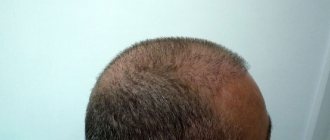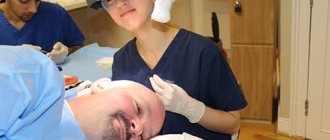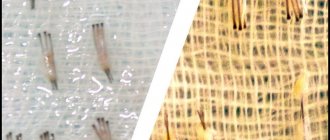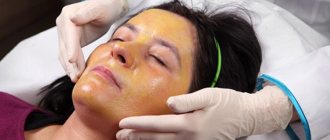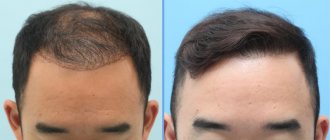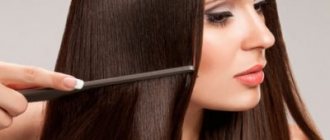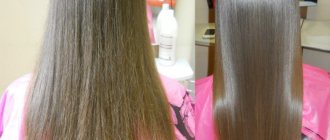FUE (follicular unit extraction) is better described as a “procedure” than a “surgery.” With this technique, the donor area is shaved into your skin so that individual follicular units (FUs) are exposed. When individual follicular units become visible, we can select by removing the most ideal FUs. Typically, the units with the most follicles are selected for removal. This allows us to maximize the number of follicles excised per graft. The average number of follicles per graft is much higher than with conventional strip harvesting and microscopic dissection with this technique.
Each follicular block is handed over to specialists after the block is removed, so that each graft is cut into excess tissue and trimmed to the ideal size for the specific recipient site. With a FUE technique such as hairless FUE, it is possible that many changes are possible where only the follicular units are shaved, which are removed and the surrounding fur is left longer. In this way, the entire transmitter area remains unchanged without specifying the procedure. This method takes longer but offers the advantage of not being completely detectable and is suitable for people who require zero post-operative interruption.
FUE seems pretty specific though - it's used to describe any extraction technique that doesn't actually involve a scalpel. Sharp, matte, manual or motorized, fist of any size.
The longer the blow, the greater the likelihood of scalp injury and donor scarring. Since the whole concept of FUE is to reduce the amount of visible scarring, using larger dies may actually increase the amount of scarring in the harvested area. Typically, small, sharp hand-held staplers can create graphics with the least amount of trauma to both the graft and the donor.
Historical Development of FUE Hair Transplant
Although the development of hair transplantation dates back to old times, hair transplantation in the world began to be used in its present meaning in the mid-1990s. Hair transplantation performed by the FUT method in the 1990s has been replaced by the FUE method, which was developed in the early 2000s and began to be used after 2005. Since then it has been continuously developed with small innovations, but the basic principles of FUE have not changed. Today it is still used as the most advanced hair transplant technique.
How is the preparation going?
Before undergoing a hair transplant in an aesthetic medicine clinic, certain preparations are required. To identify contraindications for transplantation, the doctor prescribes an examination, which includes a biochemical blood test, urine test, coagulogram, and blood tests for common infections.
This procedure is contraindicated in the following cases:
- diabetes mellitus at the stage of decompensation;
- poor blood clotting;
- inflammatory diseases of the skin in the donor area or in the area where hair is planned to be transplanted;
- age up to 16 years;
- mental illness;
- oncological diseases;
- individual intolerance to drugs for local anesthesia.
Hair transplantation is not performed in case of chaotic hair loss throughout the body, as well as if baldness is caused by radiation or chemotherapy. It is not recommended to do this procedure if the exact cause of hair loss cannot be determined.
If no contraindications are identified, then two weeks before the transplant, the patient should stop using medications intended to combat baldness. A week before the transplant, you should stop taking medications that affect blood clotting. Two days before the procedure you need to stop drinking alcohol.
Advantages of FUE Hair Transplant Technique
• More natural results are obtained using the FUE technique.
• More intensive hair transplantation can be done.
• Provides a permanent solution for mild hair loss or advanced hair loss.
• Pain is minimal.
• Does not leave scars or stitches after surgery.
• The healing process is fast.
• Does not damage the donor area during the procedure.
• The effectiveness of transplanted hair is quite high.
• The FUE technique is very open to technological developments.
• 2-3-4 root grafts are less likely to break.
• The patient's procedure is usually completed in one session.
Is this method suitable for all patients?
According to hair transplant experts, using the Choi pen during the follicle extraction phase of surgery may not be suitable for everyone. After this method was developed at Gyeongbuk National University in Korea, it was successfully used on Asians suffering from hair loss, so the technique became widespread there.
However, although doctors have had good results using the Choi implanter for hair transplants on patients of Asian descent, operations performed on people of other races have been less successful. Experts have studied this phenomenon and come to the following conclusion: Asians have dense and straight hair, while people of other races have thin and curly hair, which makes it difficult to load the Choi pen with follicles and transplant them into the scalp.
The procedure can result in curled follicles, improper insertion of follicles into the scalp, and excessive damage to the follicles. Therefore, using the Choi pen for hair transplantation may not be suitable for all patients wishing to undergo this surgery.
Painless hair transplant
Because of this fear, some patients who are afraid of feeling pain during hair transplantation postpone their surgery. But thanks to new technologies, painless hair transplantation is now possible. Thanks to sedation and hair transplantation, pain is almost never felt during surgery. This makes the hair transplant process more convenient. This method is also ideal for patients with needle fear. The pain, which is already felt very little, is thus reduced to a minimum.
Sedation is a state of sleep that is regulated by preserving all the patient's reflexes with the help of specially selected sedatives. Hair transplantation with sedation is performed at the request of the patient. Hair transplant without sedation is used for patients who do not want sedation.
Prices for hair transplantation in Moscow
How much hair transplantation costs depends on the specific clinic and your individual indications. The cost will be based on the following factors:
- chosen method;
- required number of procedures;
- transplant area area;
- anesthesia (in some clinics);
- price for transplantation of one graft or follicular unit.
Expensive clinics where hair transplantation is performed charge prices for a graft at about 100–200 rubles per unit. Average prices are 70–100 rubles/transplant, low prices are 50–70 rubles. Typically, about 2000–2500 grafts are taken for transplantation. When transplanting using the HFE method, prices vary within the same limits, but not per graft, but per follicular unit. In 1 day, within a few hours, the HFE technique allows you to transplant up to 6000 FU.
Contraindications
Hair transplantation is recommended for all patients who are concerned about thinning or hair loss, for anyone who would like to restore or get a thicker beard, mustache, eyebrows, as well as cover scars of various origins. But hair transplantation must be approached with the principle of reasonable sufficiency, understanding that the donor area is not infinite, i.e. so as not to exhaust your physical capabilities ahead of time.
Hair transplantation is not performed if:
- mental illness;
- skin diseases in the acute stage.
You should be careful when choosing a hair transplantation technique for diabetes mellitus, high blood pressure, and diseases of the cardiovascular system. Such patients are best suited to the non-surgical HFE technique, which is painless and has no complications. After transplantation procedures, be sure to follow all doctor’s recommendations for caring for your scalp and hair.
Hair transplant process
Hair transplant can be done by anyone in good health.
A person who has a hair transplant only needs to spend 3 days on the operation.
The hair transplant period varies from person to person. However, the operation time averages 6 - 8 hours.
Hair transplant must be done in a hospital. It is very important to perform the operation in a hospital so that you can intervene immediately after a possible complication.
Before FUE hair transplant
The hair transplant process begins with the patient contacting our consultants. Our experienced patient advisors will answer all your questions about the hair transplant process at this meeting.
After arriving in Turkey for hair transplant, patients are met at the airport and transferred to hotels or hospitals. When a patient comes to our clinic, the necessary tests are performed. As a result of the tests, if the patient is suitable for hair transplantation, the surgical plan is determined and the design of the anterior hairline is performed. When designing the front hairline, the patient;
• Floor,
• age and
• Criteria such as face shape are taken into account.
After the planning phase, the hair transplant phase begins.
Relevance.
In recent years, there has been an increase in the number of patients who seek an appointment with a trichologist or undergo hair transplantation with a plastic surgeon. This is due to the fact that the importance of hair on a person’s head can hardly be overestimated. Since historical times, humanity has been searching for means and methods of restoring lost hair. According to modern researchers [3,5], in order to hide baldness, 1 billion 360 million dollars are spent annually in the USA on hair transplants, purchasing wigs and hairpieces. About a third of this amount is spent on drugs that enhance hair growth. For the most part, men aged 27 to 52 years old seek help. What is this connected with? The trend of society is aimed at creating a healthy image of behavioral habits, improving the quality of life, and maintaining the phenotype of youth. In contrast to this trend, the presence of bald areas causes a certain aesthetic and psychological discomfort and emphasizes age-related changes. When approaching the diagnosis and choosing a treatment method for alopecia, medical indications such as traumatic or post-burn scarring alopecia or partial baldness associated with surgical interventions on the scalp are also taken into account [1, 2, 5].
Classification of alopecia.
Scarring alopecia:
- Post-traumatic alopecia (surgical interventions, burns, injuries);
- Systemic diseases (lupus erythematosus, Brocca's pseudopella, traction alopecia, scleroderma, follicular mucinosis, dermatomyositis, microsporia).
Non-scarring alopecia:
- Androgenetic and androgenic alopecia;
- Alopecia areata (focal, subtotal, total, universal forms);
- Diffuse alopecia;
- Seborrheic alopecia;
- Syphilitic alopecia.
Moreover, androgenetic alopecia is the most common form of alopecia. The occurrence of the latter is due to genetic predisposition. In men it is a polygenic and autosomal dominant factor, in women it is autosomal recessive. The process of baldness is localized in the androgen-dependent (fronto-parietal-vertex) region and is characterized by gradual atrophy of the hair papilla.
The degree of baldness is determined according to the Norwood-Hamilton scale (degrees 1-7), which makes it possible to detect the onset of baldness from the front hairline through the formation of bald patches. The progressive process spreads to the crown and subsequently, these zones merge with each other, forming a characteristic type of baldness.
Causes of androgenetic alopecia:
- Decreased levels of sex hormone binding globulin;
- Increased production of the enzyme 5-alpha reductase, which increases the amount of the active form of testosterone - dihydrotestosterone;
- Increased production of androgens by the ovaries and adrenal glands;
- Increased sensitivity of hair papilla cells to androgens.
Treatment and methods for correcting aesthetics.
The use of camouflages.
In order to hide bald areas from the public, various camouflage techniques are used. These are wigs of various modifications, the use of camouflage products based on the use of various microfibers, which are applied daily to areas of thinning hair. Fixing on thinning hair shafts, they give the appearance of thickness, but are easily removed when washing your hair.
Therapeutic treatment.
For patients with the androgenetic form of alopecia, dermatologists and trichologists prescribe daily application of topical lotions containing minoxidil, aminexil, azelaic acid, etc. These drugs can support hair growth and stop the development of baldness. But they are all temporary. And many patients decide to undergo hair transplantation.
Surgery.
Surgical methods of treatment:
- Autologous hair transplantation;
- Patchwork plastic;
- Excision of the area of baldness, plastic surgery with local tissues;
- Dermotensia;
- Artificial hair implantation.
Autologous hair transplantation is the most effective method of restoring hair growth in androgenetic and cicatricial alopecia [4,5]. The essence of this method is to move complexes of hair follicles (micrografts) from the zone resistant to the action of dihydrotestosterone (DHT) to the baldness zone. The donor area is the back of the head. Even a 100-year-old man always has hair and intact hair follicles in the occipital region. Once moved, the newly growing hair is hormone resistant and does not die under the influence of DHT.
Materials and methods.
Hair transplantation is performed using two methods:
- Strip method
- Seamless method (FUE-follicular unit extraction).
The strip method involves excision of a skin flap with hair follicles in the occipital region and dividing it into hair connections (grafts) ready for implantation. The resulting linear wound is sutured with a cosmetic suture. This technique is highly effective, but there are also negative aspects. When excising the strip, part of the grafts is intersected with a scalpel. When dividing a skin flap into grafts, a long time passes before implantation into the tissue. During this period, subject to all conditions of storage and preparation of the grafts, the hair growth area partially dies, and a linear scar is always preserved on the back of the head.
The most highly effective technique is seamless hair transplantation. A special feature of this method is the complete absence of a linear scar in the occipital region. Each follicular unit (graft) is removed separately with a special round scalpel. Its outer diameter ranges from 0.7 to 0.9 mm. The graft is almost immediately ready to be moved to the bald area. The advantage of this technique is that the graft is left without power for a minimum amount of time between collection and implantation, which accordingly increases its survival after transplantation. There are no visible scars left in the donor area. Pinholes in the back of the head heal quickly, leaving no marks. After the procedure, even your hairdresser will not be able to determine whether the surgeon worked there or not.
Trichoscopy
punch cut
5th day after the procedure
15 men took part in our study (9 men underwent the Strip method, 6 men underwent FUE).
Micrograft transplantation is used, which includes 1-3 hair follicles. This makes it possible to obtain more natural and aesthetically acceptable hair growth.
graft – 1 hair
graft – 2 hairs
graft – 3 hairs
Indications for hair transplantation are the following types of alopecia:
- Androgenetic alopecia in men and women;
- Cicatricial alopecia (occurring after surgery, burns, injuries);
Before the procedure, each patient undergoes a diagnosis of the scalp using an ARAMO SG microvideo camera to determine the growth density, thickness, and number of healthy hairs in the scalp. The area of the recipient site and the density of the implanted follicular units are determined. An electronic patient record is generated using HairXPPro software.
Results.
The effectiveness of the operation was determined after 6 and 12 months visually using digital photographs; counting of surviving grafts using microvideo diagnostics on an ARAMO SG device with a magnification power of x60, x200 and x1000; and subjectively, as assessed by the patient and surgeons of aesthetic parameters with an analysis of the effect of the operation (before and after).
The percentage of damaged grafts in the first group (strip method) ranged from 13 to 22%, in the second group (FUE) – from 2 to 15%.
The percentage of engraftment of hair grafts in the first group (strip method) ranged from 89 to 92%, in the second (FUE) - from 91 to 94%.
Discussion.
In world practice, certain approaches to the treatment of androgenetic and cicatricial alopecia have been formed. Regarding androgenetic alopecia in grades 1 and 2 according to Norwood-Hamilton and grade 1 according to Ludwig, it is absolutely justified to apply topical lotions that include 5-alpha-reductase enzyme blockers, constant use and the use of specialized shampoos containing ketoconazole. [9,11] This therapy allows you to maintain the viability of hair grafts for 3-4 years. This therapy is temporary, takes time and does not provide lasting results.[10] When the disease worsens and alopecia progresses to stage 3-7. according to Norwood-Hamilton for men and 2-3 tbsp. According to Ludwig, the use of topical medications in women is not effective. In recent years, various methods of stimulating hair growth have been actively introduced: microcurrent therapy, laser therapy, mesotherapy, the use of platelet-rich plasma, cryomassage, D'arsonval currents, myostimulation. But, many authors note that although these methods have been used for a long time, they do not give lasting results and the alopecia process resumes when treatment is stopped.[10] For this reason, surgical methods for the treatment of alopecia occupy a leading position.[3,4] Surgical methods include: patchwork, dermatension[7], and plastic with local tissues. Micrografting technology (transplantation of autologous hair micrografts) is increasingly being introduced into surgical treatment of the scalp. A detailed comparative analysis of various techniques showed that the use of micrografting gives the most aesthetic and predictable results. And leaves behind minimal scar tissue changes.
For this reason, many patients resort to hair transplantation. These techniques are the most effective for restoring hair growth in hairless areas. In terms of effectiveness, there are no clear differences between the strip method and seamless hair transplantation.
When performing hair transplantation using the strip method, after excision of the skin flap, a scar is left in the occipital region with a length of 20 to 35 cm. Since it is located in the tension zone, there are prerequisites for its expansion. This depends on the properties of the tissues, the healing activity and the strength of the collagen fibers. With age, these tissue properties decrease. And after the procedure, the patient is forced to wear long hair to camouflage the scar. In some situations, it becomes necessary to perform hair transplantation into a scar[9].
When performing the seamless method, these problems do not arise.
Regarding the percentage of engraftment of follicular units, the authors of the studies do not note a big difference between these methods [2,8,9]. According to our observations, the percentage of graft engraftment is 1-2% higher when performing FUE. The difference is not significant, but it is additional evidence that FUE is a safer, more predictable procedure with a minimal recovery period compared to the Strip method. If it is necessary to obtain a large number of grafts and limited donor resources, the techniques can be combined in one session to achieve the best result.
Conclusion
Thus, when choosing a technique for correcting baldness in men with straight hair, the seamless hair transplantation method is a priority compared to the classic strip method. This technique makes it possible to more accurately plan the volume of intervention by reducing trauma to the grafts at the preparation stage and increasing their survival after transplantation. An important aspect of the effectiveness of the FUE method is the absence of linear scars in the occipital region, which allows you to wear short haircuts.
Description: Patient 32 years old, male. Diagnosis: Androgenetic alopecia stage III. according to Norwood-Hamilton. Hair transplantation in the amount of 850 grafts was performed.
Description: Patient 41 years old, male. Diagnosis: Androgenetic alopecia stage III. according to Norwood-Hamilton. Hair transplantation performed using FUE method 1207 grafts
Description of the FUE method
Step 1. Carrying out markings and preparation for the procedure
Step2. Treating the surgical field with an antiseptic. Injection of anesthetic into the donor area
Step 3. Making micro-incisions using specialized equipment and removing grafts
Step 3. Making micro-incisions using specialized equipment and removing grafts
Step 4. Preparation of grafts
Step 5. Preparation of grafts
Step 6. Making micro-incisions and implanting grafts into them
5th day after the procedure
Description: Recipient zone on the 5th day after hair transplantation using the FUE method in the amount of 1049 grafts.
Literature:
- Belousov AE. Essays on plastic surgery. Volume 1: Scars and their correction. – St. Petersburg: Commander-SPB, 2005.
- Barrera A. The use of micrografts and minigrafts for the treatment of burn alopecia. Plast Reconst Surg 1999; 581.3.
- Modern approaches to the surgical treatment of baldness - the method of seamless hair transplantation / D. Papaskiri, G. Markaryan, A. Maharashvili and others // Internet resource, access mode: https://volos-tver.narod.ru/public1.html
- Valikhnovsky R.L. Rationale for the surgical-microsurgical method of treating different types of alopecia // Abstract of thesis. diss. Ph.D., Kyiv, 2006
- Goncharov A.P. Treatment of androgenetic alopecia with hair transplantation using skin micro- and mini-autografts // Abstract. diss. PhD, Moscow, 2002.
- Abu Judeh Faez Kamal. Method of intensive dermotension in the treatment of large opacities and post-traumatic wounds: Author's abstract. dis. ...cand. honey. Sci. - Kharkiv, 1997. - 17 S.
- Complications of the balloon tissue stretching method / Moroz V.Yu., Sarygin P.V., Sharobaro V.I., Vaganova N.A. and others // Spring. hir. them. Grekova. - 2000. - No. 3. — P.65-68.
- Bernstein R., Rassman W. et al. The art of repair in surgical hair restoration part I: basic repair strategies // Dermatol. Surg.- 2002.- Vol. 28. — P. 783-794
- Bilkay V., Kerem H., Ozek C. et al. Alopecia treatment with scalp expansion: some surgical fine points and a simple modification to improve the results // J. Craniofac. Surg. - 2004. - Vol. 15. - N 5. - P. 758-765.
- Abraham Zlotogorsky, Jerry Shapiro. Trichology. - Kyiv. 2013
- Gadzhigoroeva A.G. Clinical trichology – Moscow. 2014
12. Ovcharenko Yu.S. Androgenetic alopecia. Innovations in therapy/Dermatologist 2014. - No. 5.-R. 090-093
Scientific and practical journal “Practice of Aesthetic Medicine” No. 1 / 2015
Slesarenko S.V., Baranov I.V.
Family Medicine Clinic
[/vc_column_text] [/vc_column] [/vc_row]
What to Consider Before FUE Hair Transplant
Before a hair transplant, the patient must tell his entire health history. If he/she takes medications regularly, he/she should inform the doctor about these medications.
Smoking should be stopped before surgery. Smoking increases the risk of complications during surgery and slows recovery. Therefore, smoking should be stopped some time before hair transplantation.
The day of surgery should come with comfortable clothing. Especially when wearing, preference should be given to clothing that will not rub the stone (shirts, etc.).
Blood thinners should not be used before hair transplantation.
Are there any side effects or disadvantages to DHI hair transplant?
According to the medical staff of the Clinicana, “there are no advantages or disadvantages: everything depends on the instruments that doctors use to perform hair transplantation . If the doctor knows how to use instruments, this will affect the operation and its result. Choi pen, Neograft, Artas and so on... All these techniques are just tools, none of them need to be used to achieve great results. But you can use everything, and the result will still be depressing.”
However, here are the main disadvantages of this method:
- Doctors and medical staff need to undergo extensive training to master this technique.
- The medical team must consist of at least six people.
- The procedure may take longer if honey. staff are not familiar with this method.
- The cost of DHI hair transplant is usually higher than traditional methods due to the cost of Choi implants.
- Carrying out an operation in this way requires greater concentration and accuracy.
Creating Sections
In the FUE technique, the canals are opened using metal slits. When opening the channels with these metal slits, you should pay attention to the natural angle of the hair in that area. Hair transplanted into channels that are open according to their natural angle grows in accordance with their natural directions. Thus, the results of hair transplantation look natural. Hair that doesn't open up according to its angle never looks natural. Channels opened at right angles cause the patient's hair to fall out. This makes the hair look like a spiky hair.
Another issue to consider when opening a channel is that the steel blades (metal slots) do not lose their sharpness. Metal gaps that lose their sharpness cause more damage and reduce the success rate of a hair transplant. At Esthetic Hair Turkey this problem does not arise. New instruments are constantly used in our clinic. Hair transplants are not performed with steel blades, which lose their sharpness.
Hair follicle transplant
The final stage of hair transplantation is hair transplantation. At this stage, hair follicles taken from the donor area are placed one by one into open canals. You need to be very careful at this stage. Each stage has its own special moments. The expertise and experience of the team that will perform the operation is important to the successful completion of all these steps.
How to transplant hair
Without going into too much detail, hair transplantation is precisely a transplantation in the truest sense of the word. A team of doctors, usually consisting of more than eight people, takes hair from one area and inserts it into another during a multi-hour operation. Sometimes the operation time reaches 8 hours or more, and during this time up to 5,000 follicles are transplanted. As a rule, follicles are taken in the form of follicular units of 2-4 follicles (rarely more). The associations have one power system and it is in this format that it is easier to transplant them.
The hair follicle (lat. folliculus pili, also hair follicle) is a dynamic organ located in the dermal layer of mammalian skin and consists of 20 different types of cells with different functions.
Small pieces of tissue called grafts are used for transplantation. Depending on the transplantation method, the grafts are removed by the surgeon manually or using a special tool, which speeds up the work and reduces the percentage of defects. This method is used when more than 3000 grafts are transplanted. The size of the grafts is about 0.6-1 mm in diameter. At earlier stages larger “calibers” were used. As a result, the patient's head often began to look like a doll's, with the hair growing in tufts.
Already in 1936, Suji Okuda said that the smaller the size of the graft, the better the result.
Once the grafts are removed, the surgeon's assistants take care of them. They sort them by type and best suited to each specific zone. Sometimes hair is used for transplantation not from the occipital or temporal region, but also from the chest, legs and other parts of the body. In this case, only your own hair is suitable. The body is designed in such a way that foreign hair does not take root. This has been proven many times through various experiments and studies.
This is what the graft collection site looks like. In a few days everything will heal, and a little later new hair will grow.
Once Grafts are sorted, they can be placed in new locations. To do this, there is another tool that makes small punctures into which the follicles are placed.
With this method of operation, there are almost no scars left in the places from which the grafts were taken. Even on a shaved head it is almost unnoticeable. Over time, the follicles in the donor areas are restored, and the area becomes overgrown with hair again. The procedure does not remove hair from the donor area.
If you need to transplant a lot of hair, there is another way. It involves cutting larger pieces than conventional grafts. To do this, tissue flaps are taken, which are then cut into grafts and transplanted to the desired areas.
Washing after FUE hair transplant
The first wash after FUE hair transplant is performed at the hair transplant clinic. Hair follicles that are transplanted immediately after a hair transplant can be easily broken and damaged because they cannot hold their new locations tightly enough. For this reason, a specialist must perform the first wash. After the first wash, the patient does the wash himself, provided he is very careful.
During other washings, the patient should be very careful with his hair and scalp. Points that the patient should pay attention to when washing after hair transplant;
• When washing, do not put too much pressure on the scalp.
• Washing water should not be too hot or too cold.
• The water should not be under excessive pressure.
• The care products and shampoo used must be products recommended by a doctor. If the patient wants to use another product, he should first consult a doctor.
• It should not be too hard when drying.
How does transplanted hair survive?
Since the hair, roughly speaking, is simply inserted into the holes, it needs to be fixed somehow. It would seem logical to use bandages to prevent the hair from falling out as soon as the wind blows or the patient shakes his head. In fact, this is not necessary at all, since the hair holds on perfectly with the help of natural glue - the protein fibrin.
This is how the transplant area is designated before surgery.
This fixation, combined with the low-traumatic nature of the procedure, in which anesthesia, if used, is local, allows the patient to go home on the same day.
Depending on your hair type and color, within a year you will be able to evaluate the results and be surprised at how modern medicine works.
FUE Hair Transplant in Aesthetic Hair Türkiye
Esthetic Hair Turkey is a clinic that provides hair transplant services to people from many countries around the world. Our clinic, which provides services with its expert team and latest technological tools, strives for 100% customer satisfaction.
The ability to analyze the patient's needs is very important for a successful hair transplant. Experience is also necessary for correct analysis and correct treatment. To date, thousands of hair transplant operations have been performed in our clinic.
This should be performed with a team of experts and experienced in hair transplantation. At our clinic, we make sure that all our team members are experts and experienced in their field.
Aesthetic vision is also very important for successful hair transplantation. Especially the design of the front hairline changes the patient's appearance. Therefore, this design must match the patient's face shape and head structure. Good design requires aesthetic vision and experience.
Contact us for successful hair transplant at Esthetic Hair Turkey and for detailed information about FUE hair transplant.
Main Benefits of DHI (Direct Hair Implantation) Hair Transplant
In addition to the above, the advantages of hair transplantation using the direct implantation method are also the following:
- More healthy, viable follicles.
- Reducing bleeding in the transplant area.
- Reduced risk of infection.
- Reducing the risk of injury to follicles during transplantation, reducing damage to the blood flow in the transplant area.
- Fast recovery after the transplant procedure.
- Reduced operation time (provided that qualified medical professionals with experience in working with the Choi pen are working), since it is possible to make incisions and transplant follicles at the same time.
